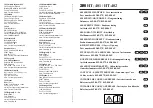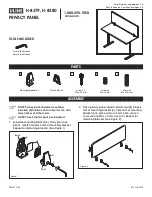
4
BATTERIES
14
4.9
BATTERY INSTALLATION __________________________________________________
If the batteries have been cleaned and any acid in the
battery rack area neutralized, no corrosion to the battery
racks or surrounding area should be present. Any
corrosion found should be immediately removed with a
putty knife and a wire brush. The area should be washed
with a solution of sodium bicarbonate (baking soda) and
water and thoroughly dried before priming and painting
with a corrosion resistant paint.
The batteries should be placed into the battery racks and
the battery hold downs
(Views A & B)
tightened snugly
to prevent movement, but not tight enough to cause
distortion of the battery cases.
Inspect all wires and terminals. Clean any corrosion from
the battery terminals or the wire terminals with a solution
of sodium bicarbonate (baking soda) and brush clean if
required.
Use care to connect the battery wires as shown in
Figure 4J and tighten the battery post hardware securely.
Protect the battery terminals and battery wire terminals
with a commercially available protective coating.
Refer to Section 2.3 for battery specifications.
Figure 4J
4.11 BATTERY CHARGING ______________________________________________________
The battery charger is designed to fully charge the
battery set. If the batteries are severely deep cycled,
some automatic battery chargers contain an electronic
module that may not activate and the battery charger will
not function. Automatic chargers will determine the
correct duration of charge to the battery set and will shut
off when the battery set is fully charged. Always refer to
the instructions of the specific charger used.
Before charging, the following should be observed:
The electrolyte level in all cells must be at the
recommended level and cover the plates.
The charging must take place in an area that is well
ventilated and capable of removing the hydrogen gas that
is generated by the charging process. A
minimum
of five
air exchanges per hour is recommended.
The
charging
connector components are
in good
condition and free from dirt or debris.
The charger connector is fully inserted into the vehicle
receptacle.
The charger connector/cord set is protected from
damage and is located in an area to prevent injury that
may result from personnel running over or tripping over
the cord set.
The charger is automatically turned off during the
connect/disconnect cycle and therefore no electrical arc
is generated at the DC plug/receptacle contacts.
AC Voltage
Battery charger output is directly related to the input
voltage. If multiple vehicles are receiving an incomplete
charge in a normally adequate time period, low AC
voltage could be the cause and the power company
should be consulted.
WARNING
Aerosol containers of battery terminal protecting must
be used with extreme care. Insulate the metal
container to prevent the metal can from contacting
battery terminals which could result in an explosion.
!
300 A
FUSE
FRONT
RED
TR009
A
B
BLACK
CAUTION
Do not overfill batteries
!















































